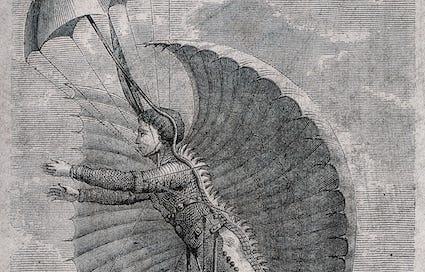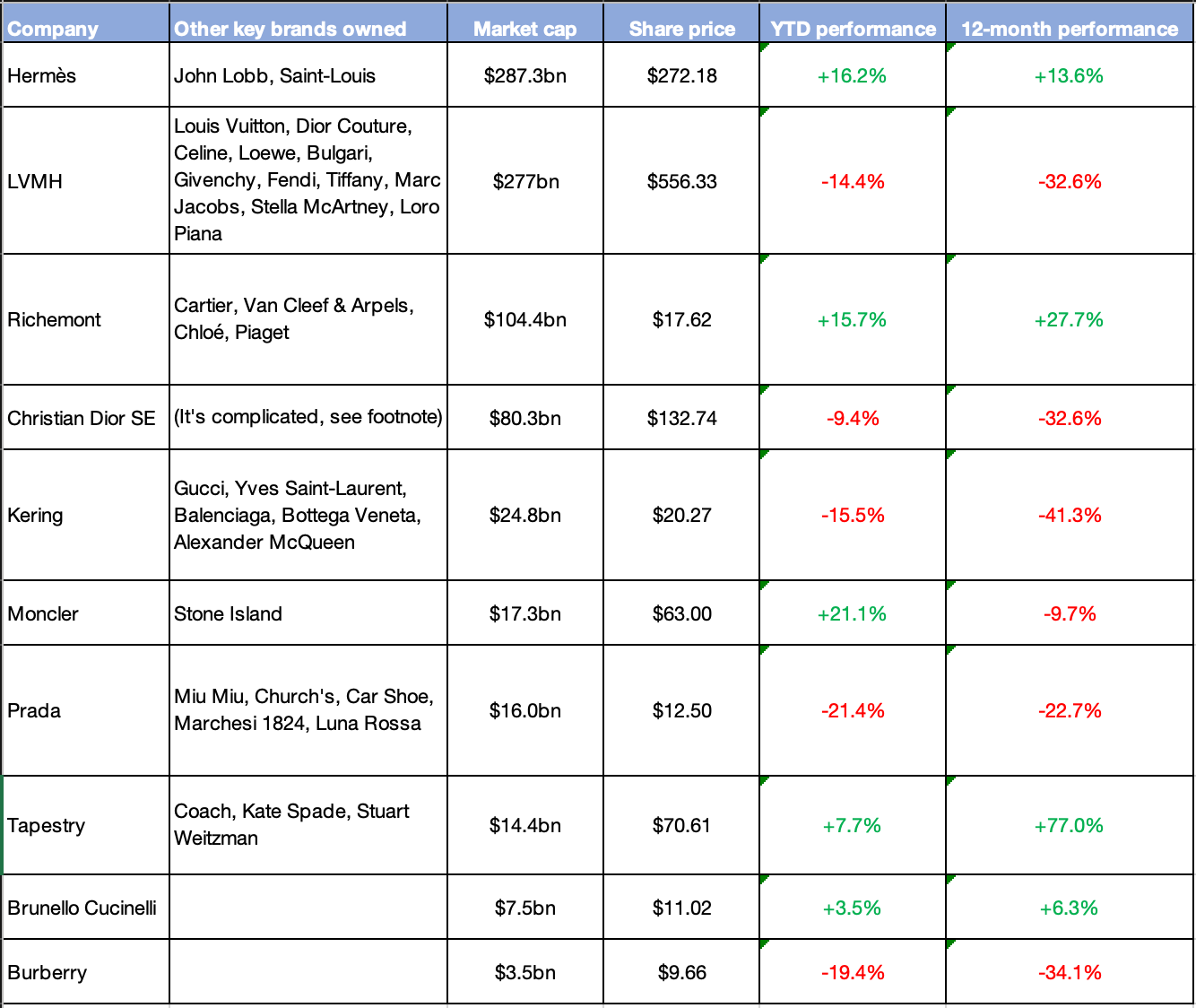Luxury brands are quiet quitting the art world again
Ad buys and collabs in the arts dry up whenever high-end retailers face cash crunches
A historical engraving by P. Sellier showing a man in a lavish, winged costume stepping off a cliff with a basket of provisions strapped to his waist. Courtesy Look and Learn via Creative Commons License.
A lot of people in the art industry tend to think that the performance of luxury brands only matters as a proxy for the health of their own trade. The logic is straightforward: Whether you’re selling expensive paintings or couture, the target audiences ultimately occupy the same tax brackets. So as one sector goes, the other will probably follow.
But there are other ways in which the behavior of luxury brands, not luxury buyers, directly impacts the art business. And as many of those companies take on water in the roiling ocean of this economy, they’re poised to chuck multiple forms of art-industry spending overboard to keep themselves afloat—just as they’ve done before.
The first indicator of trouble has been visible during major art-fair weeks for at least the better part of a year, at least to people who pay attention to the brand activations outside the expos themselves. The shift was on full display at the most recent Miami Art Week, the annual melee of art fairs and related events anchored by Art Basel Miami Beach every December. The event has become both loved and hated by art pros over the years for the bombastic, luxury-sponsored installations, parties, and giveaways that usually pop up all over both sides of Biscayne Bay. (The Carsten Höller-designed Prada Double Club helped define the week in 2017, for instance.)
Even though the quantity of brand activations stayed high at Miami Art Week 2024, however, the quality and desirability of the brands was in free fall. To paraphrase one insider working at the nexus of art and luxury, this year dealers and collectors were a lot less likely to come across anything sponsored by the types of companies that dress celebs for the Oscars than they were to encounter something sponsored by the types of companies that sell stuff you could find in a bodega. I can tell you from my time down there that the big swag prize of the most recent edition was a Chiquita banana duffle bag. If that’s not a smoking gun for luxury’s recent pullback from art sponsorships, I don’t know what would be.
The phenomenon is bigger than one event. I’ve heard nothing from art folks who were in LA in February to suggest the west coast’s Frieze Week reversed the momentum, and the only luxury brand activations I’ve encountered ahead of next week’s crush of fairs in New York involve companies with long-term partnership deals already in place. Admittedly, my inbox should not be considered the all-seeing eye on this front (I mean, look at what I spend my time doing every week), but the anecdotal evidence is largely blowing tumbleweeds in the same desolate direction.
Then there’s the persistent vulnerability of art-media companies to any cutbacks in ad spending by luxury brands, which make up far and away the highest-value category of clients for some publications. Take it from someone who was a staff editor at Artnet News during the Covid shutdowns: when high-end fashion houses and jewelers start paring down or eliminating their ad buys en masse, it can pose an existential threat to the bottom line. Remember, these publications weren’t exactly printing money even before the economic unease of the past 18-ish months set in. If the uncertainty of tariffs or, worse, the onset of a recession drives luxury brands to initiate marketing and advertising austerity in the months ahead, it will be a body blow to an art-media system that has been woozy for a long time.
So, all of this raises a simple question…
How bad are things for the luxury sector?
To ground this conversation in the hard earth of financial reality, I put together the table below. It shows how ten of the top international luxury companies by market cap have done, first, in 2025 year-to-date, and second, over the preceding 12 months.1
Data from Bloomberg and Google Finance
On one hand, four of the ten companies in the table are significantly up over the past year. That’s good! Especially given that at least a few of the brands in question (see: Hermès, Van Cleef, Cartier) have historically been strong spenders in the tributaries of the larger art industry.
On the other hand, the six other luxury conglomerates have been beaten up pretty badly over the past year. LVMH, Kering, and Prada are all down between around -22% and -42% since May 1, 2024. That’s obviously and objectively bad! But it’s even worse for the art business, because within their portfolios are the lion’s share of the brands that have been truly dedicated to funneling money and resources into our niche economy for a decade or more. This includes major labels that operate their own art foundations, like Louis Vuitton and Prada itself, as well as smaller ones that have had an outsize interest in ad buys and artist/art brand collaborations, like Loewe and Bottega Veneta. Their collective struggles are almost guaranteed to take a big bite out of multiple facets of the art business by the time 2025 is over.
Gimme one good reason to stay here
It’s worth unpacking why luxury brands tend to view ad buys in the art trades as expendable in tough times. The basic reality is that art-media publications are, at bottom, news publications, not glossy lifestyle and culture publications. This means that when the news is bad, they (surprise!) publish bad news—which is exactly what luxury brands least want to be associated with.
Think about it: If your business is selling high-end leather goods or couture gowns, why would you be excited about paying for ads that have a good chance of running alongside stories about tariffs, bankruptcies, business closures, crime, lawsuits, censorship threats, wars, discrimination, Nazi looting, pandemics, or about a hundred other interesting but depressing subjects? Stunningly, having the word “art” floating somewhere in this stomach-turning gumbo of stories changes nothing about its appeal to most luxury retailers.
To mitigate their exposure, some advertisers even formalize in their contracts with publications that their ads can’t be placed on stories with headlines or copy containing entire categories of problematic subject matter (see above) or even specific words or phrases. This wrinkle often forces art writers and editors to play three-dimensional chess when crises have to be covered. One of my wiliest tricks in 2020, for example, was coming up with the phrase “social-distancing era” to barrel-roll past bans on a whole host of Covid-related vocabulary, including “lockdown” or “shutdown,” that was essential to a lot of news stories at the time. Other advertiser-induced requirements were tougher to work around, like (I’m not kidding) having to avoid using main images with people wearing masks for several months of the aforementioned era.
So, art-media ad buys tend to be first on the chopping block for luxury retailers who need to trim costs, just like arts education programs tend to be first on the chopping block when US schools run into budget problems: they’re seen as non-essential at best, and actively harmful at worst by the people controlling the purse strings.
A lot of these same principles apply to brand-sponsored product collaborations or activations with artists and art businesses. But there’s another factor worth mentioning on these types of alliances, too. Luxury brands’ engagement with—and spending on—the art world depends largely on how much their respective creative directors care about art on a personal level. This is the main reason Dior Homme, Yves Saint Laurent, and Celine each had huge art footprints under Hedi Slimane, and why Loewe spent above its expected scale under Jonathan Anderson: both dudes are genuine fanatics about art. But there was nothing in the DNA of either brand after Slimane and Anderson’s departures that demands their successors keep the brand just as invested in the art trade. It’s an individual choice.
One silver lining on this front is Anderson’s ascension to the helm of Dior Homme, a bigger line with a bigger budget that could pay bigger dividends for art and art-media businesses soon. Still, the high rate of churn among the various creative directorships at major luxury retailers only adds to the uncertainty hovering over the wider economy like a toxic fog. The art economy is downwind from all of this in very direct ways. Now that the gales are blowing in, don’t underestimate the damage they can do.
OK, let me take a deep breath and try to explain how LVMH and Dior can both appear on this list.... Dior Couture is a brand within LVMH’s portfolio that produces clothing and accessories under the name Dior. It is related to but distinct from Christian Dior SE, the publicly traded holding company that owned around 42% of the shares (and around 60% of the voting rights) of LVMH, the conglomerate that contains Dior Couture, as of 2010. But Bernard Arnault’s family holding company, Groupe Arnault SAS, held around 70% of the shares (and around 83% of the voting rights) in Christian Dior SA—again, the largest shareholder and voting force in LVMH—also as of 2010. So, the Arnault family controls Christian Dior SA, a publicly traded company that in turn controls LVMH, a publicly traded company that in turn controls Dior Couture. QED, LVMH and Christian Dior SE are separate entities in the stock market. If you’re still here at this point, congratulations, you and I are broken in some of the same ways.






